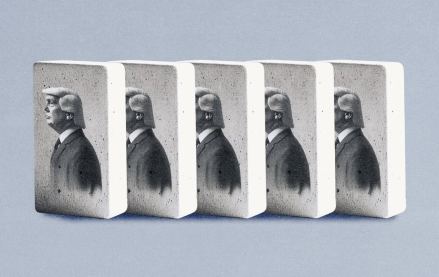Save 50% on a 3-month Digiday+ membership. Ends Dec 12.

Creators might be playing cameo roles in this year’s TV and streaming upfront marketplace – but give it time. The spotlight’s inching closer.
What started as a YouTube sideshow is creeping onto the main stage. From the talent in the room to the lingo in the air, creators cast a long shadow over this year’s weeklong industry parade.
TelevisaUnivision rolled out vertical video mini telenovelas and a creator-artist festival at its upfront.
Fox brought creators Kelon Campbell, Grant Gibbs and Ashley Gill on stage to plug their projects for Tubi, its ad-supported streamer. Amazon, meanwhile, doubled down on creator clout, announcing two more seasons of MrBeast’s blockbuster Beast Games.
And at YouTube’s upfront, creators – as always – were the show. Brittany Broski, one of the platform’s most followed stars, hosted the presentation with appearances from marquee names like MrBeast, “Hot Ones” host Sean Evans and streamer IShowSpeed. Unlike other networks that focused more on their content slate, YouTube focused squarely on its massive reach and technical scale. CEO Neal Mohan spotlighted a previously announced feature for CTV that organizes creator episodes by season, blurring the lines between streamer and studio even further,
Behind all the spectacle whether it was creators sharing panels with media execs or starring in network sizzle reels – a more foundational shift is underway. Traditional media sellers are trying to reposition their offerings not as just airtime but as cultural currency. That distinction is becoming table stakes in a market where legacy players can no longer afford to fight over scraps in shrinking media categories. Instead, they’re chasing a bigger piece of a growing digital ad pie and creators are among their sharpest tools to get there.
“There’s a forced humility from the networks and streamers that wasn’t there before,” said Becky Owen, global CMO at influencer marketing agency Billion Dollar Boy. “They want cheaper production and subsequently cheaper marketing of them. Creators provide that but more importantly they have proven formats.”
Still, this isn’t a one-way value exchange. Networks and streamers offer creators something they can’t always get on their own: prestige, professional production and big brand advertisers. What’s emerging is a new quid pro quo: creators bringing built-in audiences and low-cost production – media companies offer scale and prestige.
“For people who want to be seen and amass their audience, making a deal attractive to them can be a little bit easier if you have a show to offer, or you’re able to build contracts around the access they get to executives,” said Taylor Michelle Gerard, vp of creative and creator at Blue Hour Studios, the content and creator marketing division of Horizon Media.
Which is why, even as this shift spills onto one of advertising’s biggest stages, it’s still far from full speed. Both sides have leverage. Now, they’re figuring out how to share it. And that learning curve comes with friction. Because even as creators gain traction, the question of how much risk buyers are willing to absorb – and who’s accountable when things go sideways – is still very much on the table.
“Unlike well-known celebrities whose lives and careers have been tracked for years, many content creators exploded onto the scene quickly,” said Iliya Rybchin, a principal for strategy and innovation at management consulting firm BDO. “As a result, there are many risks that the producers and salespeople at a network can introduce in their frenzy to sign hot talent. Content creators require a special level of due diligence that very few organizations perform and as a result are ill-prepared for the consequences.”
So it made sense that creators played a supporting role at this year’s upfronts. That won’t last, of course. The forces behind this shift, particularly those pushing from the creator side, are too strong. More and more creators are turning to networks and streamers to diversify their audiences and build new revenue streams now that it is clear the platforms they came up on aren’t all that interested in developing talent beyond their own walls.
This year’s upfronts was a manifestation of all of that.
“Creators want more than exposure – they want stability,” said Jim Marsh, founder of consulting firm JMC Strategic Intelligence. “A lot of creators want to be on TV. Not necessarily for fame or relevance, but because it still represents legitimacy and a real career path. They’re looking for something sustainable – not just reach.”
More in Marketing

How Costco stood against Trump’s agenda on tariffs, DEI this year
Costco has continuously been held up as an example of a company that has stood firm in its willingness to do what it believes is best for the business.

Brands look to experiential marketing as antidote to AI slop, digital fatigue
Brands are prioritizing experiential and IRL marketing as an antidote to ‘AI slop’ and digital fatigue.

Agencies push curation upstream, reclaiming control of the programmatic bidstream
Curation spent much of this year in a fog, loosely defined and inconsistently applied. Agencies say they plan to tighten the screws in 2026.








